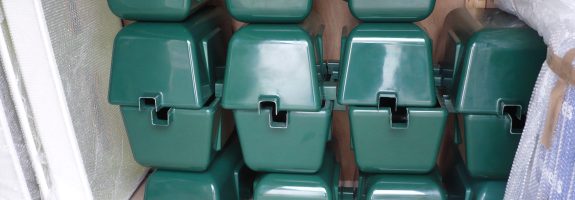
APH3G offers this versatile process utilising the compressive strength of resins with the tensile strength of the fibres to produce high strength components, the material combines lightweight with inherent strength. We produce high quality parts that are stable and offer a high level of chemical resistance.
Fibreglass products are produced by coating an open mould with gel coat. Layers of glass fibre are then built up with plastic resin being manually applied. The result is left to cure (i.e. for the resin to harden) before the mould can be reused.
In addition we can offer Vacuum Bagged / Resin Infusion process for applications.
We can manufacture parts utilising either Polyester, Vinyl Ester or Epoxies Resins.
We can facilitate all aspects of moulding from producing our own patterns and plugs, through to bespoke one off prototypes & low volume production quantities. Our patterns can be produced in a variety of materials to achieve specific customer requirements. APH3G can manufacture suitable trimming fixtures in house to ensure repeatable, high quality parts. We can also offer additional services like surface finishes, painting & assembly.
APH3G serve customers in various industries including Aerospace, Automotive, Electronics & Shop Fitting. Key customers include Lotus Cars, ESL Landscapes, Eurostar, Jaguar Land Rover, MBDA and Leonardo UK
A wide variety of components have been produced from Lighting Generators, Trailers, Vehicle Center Consoles, Environmental and EMC Shielded Covers through to Aircraft Simulators.


An adaptable and versatile process allows the creation of parts from saucepan lid size to storage tank covers many metres in diameter. As it implies the word fibreglass or GRP ‘does exactly what is says ’ utilising glass fibres (in forms ranging from chop strand matting to woven fabrics). With our focus on accuracy, we’re a top choice for GRP fabrication. These various weaves (depending on how they are laid during the application of liquid resin) can impart very high stiffness and resistance to bending in a panel or beam or compressive strength in a column design.
The process involves the application of a thermosetting resin, which can be polyester, vinylester or epoxy based into a single or multiple glass reinforcement layers either as matting or as woven type cloth. But in more detail the process is as follows:
Using the master mould, coats of releasing wax will be built up by hand, like polish. This will ensure that the finish cured fibreglass part will be able to be removed from mould.
A resin ‘gelcoat’ (which is the material which gives most fibreglass parts that high gloss appearance) is applied in 2 coats over the release wax, and allowed to become ‘tacky’. At this point, loose glass strands can be brushed into any fine detail areas and then repeat layers of glass and resin are built up to achieve the required part thickness. Each layer is then rolled to be sure that the liquid resin has fully impregnated each layer of glass and that any air entrapment is removed.
The desired thickness of part would be pre- determined to achieve the strength required over the total area or by increasing glass and resin in localised areas for high strength. Normally the fibreglass in mould will be fully cured and dry within 10 hrs, at which time the parts will be ejected via air pressure applied through discreet locations or just by flexing the part
Yes they can. At APH3G we can assemble mechanical parts hinges, Tappex fasteners, gas strut anchor attachment points etc to match our customers requirements. In addition bushes and studs can be fitted to enable matching halves of machine covers to align perfectly. So within reason almost any mechanical feature can be included into the moulding.
Fibreglass is trimmed often to deliver a clean edge to a moulding, which by the nature of method will always have a feathering of glass in some areas. Using in house manufactured trimming fixtures along with routing machines fitted with diamond tipped cutters, the parts are machined back to pre marked mould witness lines. Access apertures and any required hole patterns can also be CNC machined into the component.
The exterior finish of a fibreglass part is as high, as any buyer of a sports car would expect on a GRP body. This analogy is used to capture the quality of gloss, almost lacquer like finish achievable. Of course this type of finish is only possible with absolute attention to the detailed finish of the master pattern. These are either CNC machined in high density tooling board as one piece, or as a set of parts for very large patterns, subsequently keyed together bonded and reinforced.
Traditional wood materials are also used to make the simpler less contoured patterns offering a low cost option. But whether machine or hand made the resulting pattern will have patient super finishing applied. This pattern will be used to make the structurally supported master mould, from which one or more fibreglass parts will be laid up.
With respect to colour options, the gelcoat (which is pigmented resin) can be matched to any desired colour from the RAL or Pantone range, within manufacturers range or matched from customers master sample In addition to the finish from in mould gelcoat, spray finishes can be applied that can achieve metallic effects, the finish can be matt if required by finishing the pattern matt. This will then also give the same matt surface finish to the master mould.
There are no limitations, this allows complete freedom for the creative designer or stylist. Of course we may then have to machine the pattern and incorporate some loose sections to allow us to eject the part from the mould. It is worth bearing in mind at the design stage, that the less undercut areas you design into the tool the better, as this will have a bearing on the part manufacturing cost. APH3G are always happy to assist in the design, if you have any questions that you would like answering
Yes, this is an area where the benefit of using fibreglass parts has been recognised for many years, but as with everything, new applications are often encountered. Historically, architects have specified fibreglass building components literally from the ground up. Including foundation, drainage covers, planter boxes, landscaping seating, porch columns, windows and sills, roof cornice, dentil moulding, ridge sections, dormer canopies, cosmetic chimney stacks and roof mounted air conditioning. APH3G can create master patterns that will be used to make replacement fibreglass mouldings. Particularly in London, where matching of new to old demands from surviving pieces of cornice or similar architecture, Our fibreglass mouldings will last for years to come.
No, by observation the diversity of fibreglass products is vast, applications in nuclear, marine, mass transit, oil, automotive, leisure, industrial, machine tools, and home, the list is endless. However, the adaptability of this material and its capability to withstand the most hazardous and extreme climatic conditions including low smoke fire retardant specifications makes GRP the only logical choice.